Prevention of Global Warming
Basic Approach
The ENEOS Group is reducing CO2 emissions across the entire supply chain in order to contribute to the development of a decarbonized society.
To reduce our greenhouse gas emissions, we are focusing on energy conservation in our business activities. We are also helping to reduce the overall greenhouse gas emissions of society through the expansion of our renewable energy business, early practical implementation of hydrogen and carbon-neutral fuels, and development and sales of environmentally friendly products that have a lower environmental impact.
For our company-wide initiatives to address climate change and TCFD-related information, see Our Response to Climate Change Risks and Opportunities (TCFD).
Structure
For information on our structure, see Environmental Management.
In May 2024, we established the Carbon Neutrality Promotion Committee, chaired by the CTO, to promote carbon neutrality across the Group. The committee updates the basic strategies in response to the business environment, while the operating companies formulate specific action plans based on these basic strategies.
Material Issues, Plans and Results
Fiscal 2023 Targets, Results and Progress
Evaluation:Achieved/Steady progress Not achieved
| Material ESG Issue | Initiative | Target (KPI) | Results/Progress | |
|---|---|---|---|---|
| Contribution to the development of a decarbonized society | Reduction in CO2 emissions (Reduction amount through independent efforts) | Reduction in CO2 emissions: Reduce emissions to 30 million tons or less | Emissions: 25.41 million tons | |
Results
- For information about , see the Editorial Policy.
Changes in Total GHG Emissions (Scope 1+2)
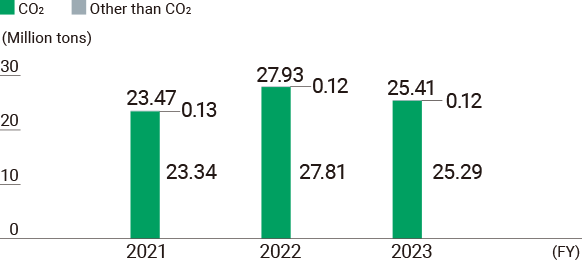
- Notes:
- Calculated in accordance with the Act on Promotion of Global Warming Countermeasures. From fiscal 2022, calculations take into account electricity sold and heat sold.
- For detailed data, see Data.
- The Group’s GHG emissions (Scope 1 and 2) are calculated using the controlled approach in the GHG Protocol and cover main applicable organizations.
Energy Consumption Intensity for Oil Refining
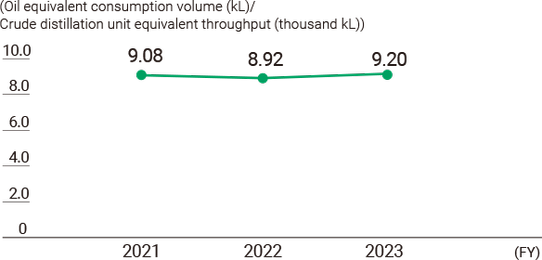
- Note:
- Covers the oil refining sites of the ENEOS Group.
Breakdown of GHG Emissions Other Than CO2 (Fiscal 2023)
| Items | Unit | Emissions |
|---|---|---|
| Total GHG emissions other than CO2 | Tons | 124,411 |
(1) CH4 (methane) |
Tons | 29,204 |
(2) N2O (nitrous oxide) |
Tons | 93,029 |
(3) HFCs (hydrofluorocarbons) |
Tons | 1,711 |
(4) PFCs (perfluorinated compounds) |
Tons | 0 |
(5) SF6 (sulfur hexafluoride) |
Tons | 467 |
(6) NF3 (nitrogen trifluoride) |
Tons | 0 |
The main greenhouse gases other than CO2 are CH4, produced during crude oil and gas production, and N2O, which is emitted from heating furnaces during the oil refining process.
We will continue working to lower these and other GHG emissions.
Carbon Neutrality Plan
Target
GHG Emissions Targets (Scope 1+2)
| Applicable companies | Items | FY2023 results | FY2024 targets | FY2025 targets |
|---|---|---|---|---|
| ENEOS | GHG emissions | 23.98 million tons | 28.15 million tons or less | 29.66 million tons or less |
| Reduction in emissions from refineries, etc. | -0.57 million tons | -0.50 million tons | -0.51 million tons | |
| CCS | Selection of potential storage sites | Determination of storage sites | Detailed design | |
| Forest absorption Credits created* |
Cumulative total of 0.23 million tons created | Cumulative total of 0.23 million tons created | Cumulative total of 0.54 million tons created | |
| ENEOS Xplora | GHG emissions | 0.71 million tons | 0.63 million tons or less | 0.62 million tons or less |
| Methane emissions | 802 tons | 1,000 tons or less | 350 tons or less | |
| CCUS | 0.25 million tons | 1.12 million tons or more | 1.12 million tons or more | |
| JX Advanced Metals | GHG emissions | 0.72 million tons | 0.72 million tons or less | 0.72 million tons or less |
| Group total (Reduction compared to 2013) |
25.41 million tons (-10.52 million tons) |
29.50 million tons or less (-6.43 million tons) |
31.00 million tons or less (-4.93 million tons) |
|
- *The amount of credits created for forest absorption is the estimated amount of CO2 absorbed by the constituent project (annual average).
To reach these targets, we are focusing our efforts in three main areas.
- 1) Curbing Group greenhouse gas emissions by improving the energy efficiency of our manufacturing and business operations through energy saving, fuel conversion, and the use of renewable energy.
- 2) Using carbon dioxide capture and storage (CCS) for emissions remaining after the above measures are carried out, and storing the captured CO2 underground.
- 3) Any remaining greenhouse gas emissions after the above two measures will be removed through forest absorption and other natural absorption methods.
Major Initiatives
Energy Conservation at Production Sites
The Group’s refineries and plants are pursuing energy conservation through measures such as increasing the number and efficiency of heat exchangers and introducing higher efficiency rotary equipment.
The Group’s GHG emissions (Scope 1+2)* in fiscal 2023 totaled 25.41 million tons, down from the previous fiscal year. In addition to improvements in the efficiency of operations, this decline was attributed to the reduction in refinery operations due to a decline in domestic demand and refinery troubles, along with a reduction in the operation of facilities for generating electricity to be sold due to fluctuations in electricity market prices.
Meanwhile, our crude oil refining energy consumption intensity worsened by 0.28 points from the previous fiscal year to 9.20 (oil equivalent consumption volume (kL)/crude distillation unit equivalent throughput [thousand kL]) due to the reduction in refinery operations.
In fiscal 2023, the Group invested around 0.61 billion yen in facilities for energy conservation. Going forward, we remain committed to pursuing greater energy conservation by introducing energy-saving technologies and optimizing operations at our refineries and smelters.
- *Calculated in accordance with the Act on Promotion of Global Warming Countermeasures.
Introduction of CO2-Free Electricity at Principal Metals Business Sites
Approximately 60% of the JX Advanced Metals Group’s total CO2 emissions (Scope 1+2) come from electricity. In fiscal 2020 it began introducing CO2-free electricity* to reduce its CO2 emissions. In fiscal 2023, the JX Advanced Metals Group completed the switch to CO2-free electricity at most of its sites in Japan and overseas.
- *Electricity derived from effectively non-fossil power sources that do not use fossil fuels and do not emit CO2, and have an adjusted CO2 emission factor of 0.00 t-CO2/kWh. In addition to power generation from renewable energy such as hydro power, wind power, and solar power, nuclear power generation may also be included.
Initiatives in Research and Development
The Group is moving forward with research in the following fields in order to realize energy transitions.
In fiscal 2023, the ENEOS Group spent a total of around 32.1 billion yen on research and development.
- Technical development for the manufacture, storage, transport, and supply of CO2-free hydrogen derived from renewable energy
- Technical development for the manufacture of synthetic fuels from CO2-free hydrogen and CO2
- Technical development for the manufacture of hydrogen and the optimization of storage battery operation plans, which contribute to the effective use of renewable energy
- Technical development and feasibility study on biofuels
- Technical development on recycling of plastic resources and used tires
- Rationalization and streamlining of oil refining processes using digital technology, etc.
- Development of environmentally friendly products (fuel-efficient automotive lubricants, etc.)
Initiatives of ENEOS Lab with Waseda University as a Joint Research Base
In November 2019, ENEOS concluded an agreement with Waseda University on comprehensive collaboration activities to promote innovation toward achieving a sustainable society. Through multi-disciplinary open innovation, from innovative technology to humanities and social sciences that indicate how the social implementation of technology should be, we are exploring the seeds that will contribute to the realization of a carbon-neutral society.
Development of Manufacturing Technologies for Synthetic Fuels Derived from Renewable Energy
ENEOS is working on the development of manufacturing technology for synthetic fuels that can replace fossil fuels such as jet fuel, gasoline, and diesel to achieve carbon neutrality in a wide range of fields, such as aircraft and vehicle mobility and raw materials for chemicals and lubricants.
Synthetic fuels are carbon-neutral fuels produced using CO2-free hydrogen derived from renewable energy and CO2, which means that they can reduce CO2 emissions throughout the product lifecycle. In addition, as their properties are equal to those of conventional fossil fuels, these synthetic fuels can be acceptable in existing vehicles, refinery facilities, and distribution routes, meaning they will play a vital role in realizing energy transitions.
ENEOS aims to establish manufacturing technologies for synthetic fuels early and their social implementation with the support of the Green Innovation (GI) Fund*, which was adopted in April 2022.
- *A fund administered by the Japanese government that provides support to companies working to address management issues to help reach Japan’s goal for carbon neutrality by 2050. The fund offers ongoing financial assistance over a 10-year period in areas ranging from R&D and demonstration projects to social implementation, covering fields in energy-related industries, including the hydrogen and ammonia fuel industries; transportation and manufacturing-related industries; and household and office-related industries.
Synthetic Fuels Production Process
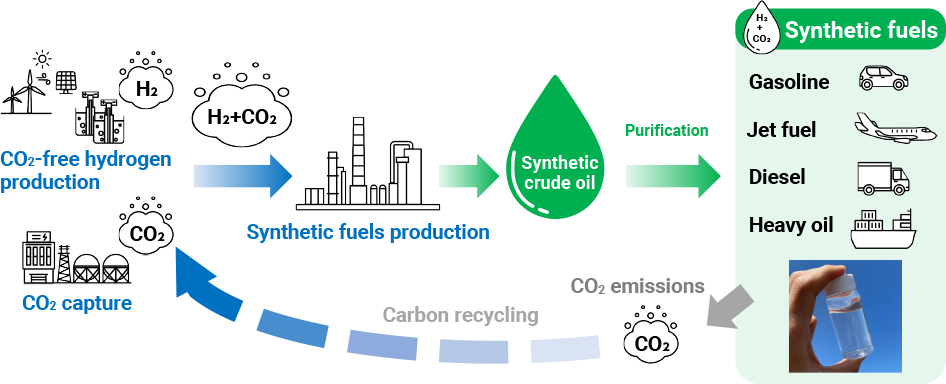
Supporting Research on Hydrogen Energy Supply through the ENEOS Hydrogen Trust Fund
ENEOS established the ENEOS Hydrogen Trust Fund in March 2006 in order to help speed up the realization of a hydrogen society.
The fund is Japan’s first public trust specializing in supporting research on the supply of hydrogen energy. The fund is large enough that a stable supply of research grants worth 50 million yen (up to 10 million yen per project) can be provided for around 30 years to support innovative and pioneering basic research into hydrogen energy supply systems. As of June 2024, the fund’s assets total around 600 million yen, which will make it possible to provide stable grants for approximately 12 years going forward.
Developing Manufacturing Technologies for Bioethanol (Cellulosic Ethanol)
In the journey to carbon neutrality, bioethanol is expected to be used in various applications such as automobile fuels and raw materials for chemical products. In recent years, it has also attracted attention as a raw material for sustainable aviation fuel (SAF). On the other hand, the bioethanol produced around the world today comes mainly from food crops such as sugarcane and corn, raising concerns that it may compete with food.
ENEOS is developing technology for producing bioethanol (cellulosic ethanol) using cellulose resources that do not compete with food, such as woody biomass like pulp and used paper, as raw materials. At the end of 2023, ENEOS concluded a joint development agreement with TOPPAN Holdings Inc., aiming for commercialization through a project combining the preprocessing process developed by TOPPAN Holdings using hard-to-recycle used paper as a raw material and the ethanol continuous production process developed by ENEOS.
In addition, ENEOS Corporation, Suzuki Motor Corporation, Subaru Corporation, Daihatsu Motor Co. Ltd., Toyota Motor Corporation, Toyota Tsusho Corporation, and Matsuda Motor Corporation are jointly participating in the Research Association of Biomass Innovation for Next Generation Automobile Fuels to promote research on production technology for bioethanol fuels for automobiles.
Initiatives in Procurement and Logistics
With regard to marine transportation, which primarily involves the transport of crude oil to Japan, ENEOS is making active efforts to use oil tankers with superior delivery efficiency and fuel efficiency, and to improve fuel consumption by optimizing transportation routes and controlling navigation schedules and speeds.
Regarding land transportation, in addition to consolidating oil depots and improving the distribution efficiency of tank trucks, we are working to reduce fuel consumption through efforts such as insisting that drivers turn off their engines when stopped.
CO2 Emissions from Domestic Transport
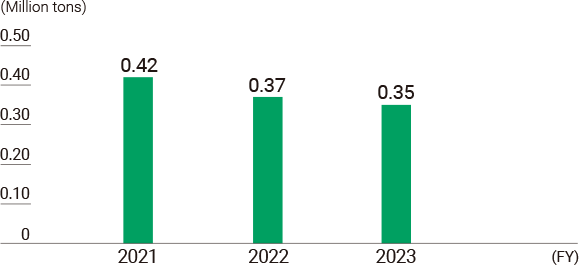
- Notes:
- Scope: ENEOS
- Domestic transport based on the Act on Rationalizing Use of Energy and Shifting to Non-fossil Energy (Energy Conservation Act)
Distribution Stage Initiatives
ENEOS is actively implementing power-saving measures at its service stations nationwide through efforts such as the installation of solar panels and the adoption of LED lighting.
Consumption Stage Initiatives
The Group’s CO2 emissions from the use of sold products (Scope 3) in fiscal 2023 totaled 166.00 million tons.
The ENEOS Group is working to reduce CO2 emissions at the consumption stage through the development and sale of environmentally friendly products, which contribute to a lower environmental impact. We have specified standards and procedures for certification of our environmentally friendly products and services and manage these appropriately.
Main environmentally friendly products
- Fuel-efficient/high-performance multipurpose lubricants
- Specialized fluids for electric vehicles and hybrid vehicles
- Natural gas and LNG
- High-performance cleaning agents
- Liquid crystal polymers
- Electricity generation using renewable energy
Sales of Carbon-Offset Natural Gas and LNG
In fiscal 2021, ENEOS began selling carbon-offset1 natural gas and LNG through the use of CO2 credits2 from overseas forest protection projects, and is supplying these products to utility gas providers.
ENEOS’s carbon-offset natural gas and LNG utilize CO2 credits generated from forest protection projects to reduce greenhouse gas emissions on a global scale. ENEOS is also contributing to the creation of local employment and the protection of biodiversity through these efforts.
- 1The CO2 emitted in the process from extraction to combustion of natural gas is offset to virtually zero.
- 2CO2 credits attested by a highly reliable verification institution for CO2 reduction effects generated by environmental conservation projects.
Working with Business Partners (CSR Procurement)
We implement CSR procurement, in which we take into account social impacts, such as effects on the environment, when purchasing materials and other goods and services.
For details, see Supply Chain Management.
Visualizing CO2 to Reduce Greenhouse Gas Emissions
We are working toward the visualization of greenhouse gas emissions in order to reduce these emissions in the Group and in society.
ENEOS established a CO2 visualization system because it is important to determine emissions in a timely manner in order to reduce emissions at its refineries. We established this system to enable centralized management of company-wide emissions and calculation of emissions (carbon footprint: CFP1) for each product. This is the first CFP calculation in the domestic petroleum industry that uses real data obtained at refineries.
The system will be used to streamline statutory reporting, manage the implementation of plans through monthly forecasting and result management, and provide CFP data to customers. In 2024, we started providing CFP data for some products to customers, and we plan to gradually expand the scope of the applicable products.
The development of this system aims to achieve unified monitoring and management of carbon information on a per-product basis, analyze the impact that decarbonization initiatives in manufacturing has on CFP and visualize CFP at the new product planning stages, and create business opportunities by highlighting the environmental value of low-carbon products.
Our CFP data will be “cradle to gate2,” meaning it will cover all greenhouse gas emissions from raw materials procurement to product shipment. We will use the life cycle assessment (LCA) method3 to calculate emissions associated with material procurement and product manufacturing.
- 1Carbon footprint of products (CFP) is a system for converting greenhouse gas emissions throughout the life cycle of a product or service, from the procurement of raw materials to manufacturing and beyond, to CO2.
- 2Refers to the process from raw materials procurement to production within the life cycle stages, comprising raw materials procurement, manufacturing, distribution, sales, use and maintenance, disposal and recycling.
- 3LCA (life cycle assessment) methodology involves quantitatively evaluating the environmental effects of product manufacturing throughout the entire life cycle from procurement of raw materials to manufacturing, transport, use, and disposal.
ENEOS Group CO2 Visualization
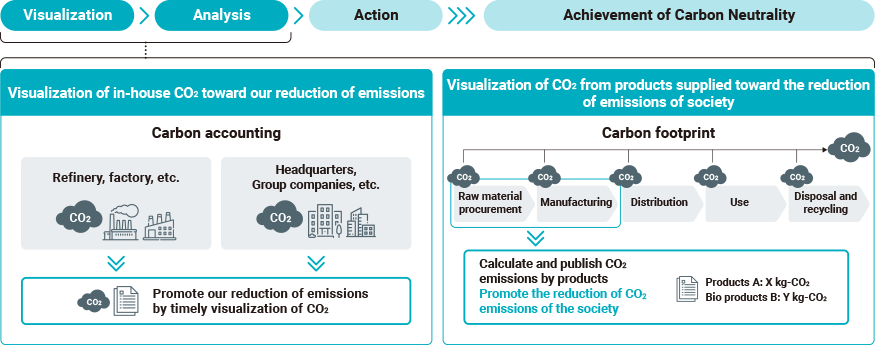
Businesses Helping to Address Climate Change
Advancement of Renewable Energy Power Generation Business
The Group has been advancing this business with the target of expanding the total capacity of our renewable power generation portfolio in Japan and overseas to over two million kW by the end of fiscal 2025. With the integration of ENEOS’s renewable energy business into ENEOS Renewable Energy (ERE) in April 2023, we are seeking the further growth of our renewable energy business. Our renewable energy power generation capacity stands at approximately 1.27 million kW (as of June 2024, including projects under construction).
ERE is one of Japan’s leading energy suppliers, with a high level of business development capability. Combining this with the Group’s expertise in the energy business, we will further develop and speed up the business to become Japan’s leading supplier of renewable energy and contribute to the realization of the 3E+S (energy security, economical efficiency and environment plus safety) of energy in a decarbonized society.
For information on our renewable energy power plants, see the ERE website.
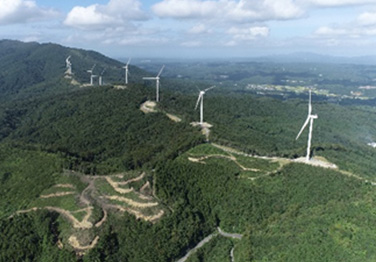
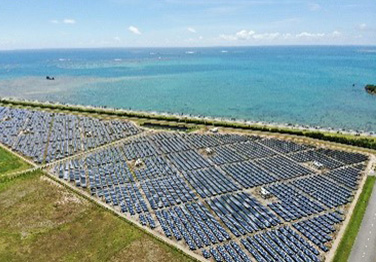

Planned Power Generation Projects
| Power generation project | Generation capacity* | Planned start of operation | |
|---|---|---|---|
| Japan | Niigata First Mega Solar Power Plant | 18 MW | December 2024 |
| JRE Oita Beppuwan Wind Farm | 9 MW | February 2025 | |
| Kudamatsu Fourth Mega Solar Power Plant | 17 MW | November 2025 | |
| JRE Sakata Wind Farm (replace) | 21 MW | January 2027 |
- *100% of generation capacity
Generation Capacity by Energy Source (As of June 2024)
| Thermal1 (9 sites) |
Oil, etc. (7 sites) |
917 MW |
| LNG(CCGT2) (2 sites) |
598 MW | |
| Solar (90 sites) | 898 MW | |
| Hydro (1 site) | 5 MW | |
| Wind (12 sites) | 179 MW | |
| Biomass (2 sites) | 91 MW | |
| Total | 2,645 MW | |
- 1Thermal capacity does not include refinery in-house power generation.
- 2Gas-fired thermal power plant with combined cycle gas turbines (CCGT)
Renewable Energy Power Generation (Fiscal 2023)
| Solar | 1,059,534 MWh |
| Hydro | 23,336 MWh |
| Wind | 364,611 MWh |
| Biomass | 506,487 MWh |
| Total | 1,953,969 MWh |
The GHG emission factor* for ENEOS’s electric power business in fiscal 2023 was 0.000506 t-CO2/kWh (after adjustment; provisional figure).
- *Greenhouse gas emission factor (after adjustment) for regular service offerings (excluding renewable energy/renewable energy [FIT] services and CO2-free electricity services).
Establishment of a Hydrogen Supply Chain
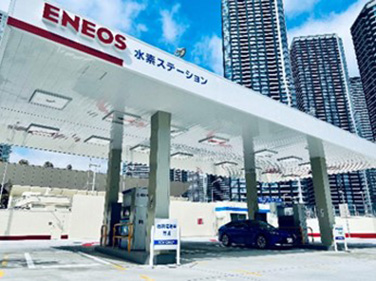
Hydrogen has the potential to contribute to decarbonization in a wide range of economic activities in power generation, transportation, and other industrial sectors. We see hydrogen as one of the promising next-generation energy sources that holds the key to achieving carbon neutrality.
First, in the transportation sector, there are around 8,500 fuel cell vehicles (FCVs) (as of July 31, 2024), and approximately 160 hydrogen stations located nationwide in Japan. ENEOS operates 35 of these facilities (as of July 31, 2024). The growth of FCVs as commercial vehicles is expected due to factors such as their hydrogen refueling time and driving range. The Japanese government has prioritized support for commercial vehicles in its Basic Hydrogen Strategy, and we are also considering the development of hydrogen stations in line with this strategy. In addition, as part of our carbon neutrality efforts, at some hydrogen stations we have introduced water electrolysis on-site and are selling CO2-free hydrogen using electricity derived from renewable energy.
Furthermore, with an eye on the future mass consumption of hydrogen, including in power generation and industrial fields, ENEOS is implementing a number of collaborative projects with local governments and leading companies in Japan and overseas for the early establishment of a supply chain for transporting and supplying Japan with green hydrogen produced overseas, where there is abundant renewable energy and other resources. As part of this effort, we are focusing on methylcyclohexane (MCH), a hydrogen carrier, in order to transport green hydrogen from overseas to Japan in large quantities and with high efficiency. We are now working on the development of our proprietary Direct MCH® technology, which contributes to cost reduction (see the news release for details).
Additionally, ENEOS refineries have the potential to serve as hubs for the stable supply of hydrogen due to the fact that they already have expertise in safely handling large quantities of hydrogen, can utilize existing infrastructure, such as ports, piers and tanks, and are located near power plants and steel mills, which are expected to require large amounts of hydrogen. We will fully utilize these advantages in the development of a hydrogen supply chain.
Building a Supply Chain for CO2-Free Hydrogen Using Our Refineries as Hubs
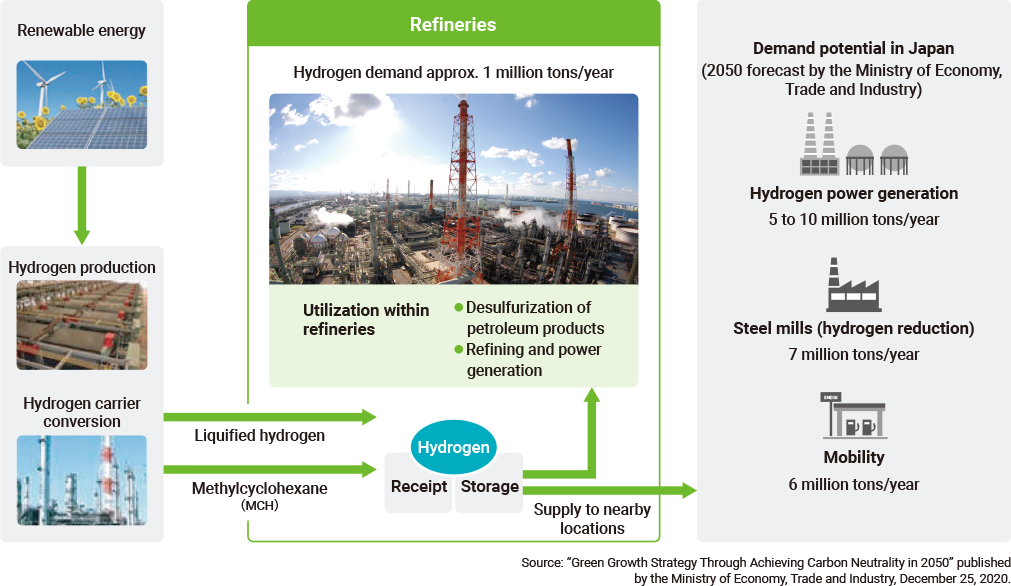
Initiatives for the Development of a Hydrogen Supply Chain
Overseas
| Project/Organization | Region | Overview |
|---|---|---|
| Development of a Japan-Australia CO2-free hydrogen supply chain | Australia | ENEOS is studying collaboration on the potential for the low-cost, stable supply of hydrogen produced from renewable energy with two Australian companies, Neoen Australia Pty Ltd and Origin Energy Limited. The projects will study more efficient production of methylcyclohexane (MCH) and maritime transport of MCH to Japan as a form of hydrogen storage and transport. For more information, see the following news releases. ・Neoen Australia Pty Ltd: news release ・Origin Energy Limited: news release |
| Development of a CO2-free hydrogen supply chain (derived from renewable energy) in Malaysia | Malaysia | The project will manufacture several tens of thousands of tons of CO2-free hydrogen in Sarawak, Malaysia using electricity derived from renewable energy generated at a hydroelectric power plant. Thereafter, the hydrogen will be converted to MCH and transported by chemical tanker to demand centers outside Malaysia. For more information, see the news release. |
| Collaboration for development of a CO2-free hydrogen and ammonia supply chain with Saudi Aramco | Saudi Arabia | The project will conduct feasibility studies on a business for hydrogen manufacture from fossil resources produced and supplied by Saudi Aramco, a business for the capture and storage of CO2 emitted during the manufacturing process, and the maritime transport of hydrogen to demand centers using ammonia or MCH. For more information, see the news release. |
| Joint study agreement to evaluate development of a clean hydrogen supply chain between the UAE and Japan | United Arab Emirates | The project will conduct a feasibility study on the utilization of by-product hydrogen from Abu Dhabi National Oil Company (ADNOC)’s refinery and petrochemical plant and blue hydrogen produced from natural gas. The hydrogen will be converted to methylcyclohexane (MCH) for export to Japan. For more information, see the news release. |
| Equity participation for building a hydrogen supply chain between Japan and the U.S. | United States | In order to verify the commercial feasibility of manufacturing cost-competitive clean hydrogen in the Gulf of Mexico and exporting MCH to Japan, we made an equity investment in MVCE Gulf Coast, LLC, a U.S. company. For more information, see the news release. |
Japan
| Project (Location) | Overview |
|---|---|
| Selection for NEDO Green Innovation Fund | The following four demonstration projects were selected by the National Research and Development Agency, New Energy and Industrial Technology Development Organization (NEDO) for its Green Innovation Fund (available in Japanese only): (1) large-scale demonstration of an MCH supply chain; (2) direct MCH electrosynthesis (Direct MCH®) technology development; (3) hydrogen single fueled power generation equipment demonstration; and (4) demonstration project for the commercialization of a liquefied hydrogen supply chain. The demonstration project period is planned to last until the end of fiscal 2030 (end of fiscal 2029 for (4)). For more information, see the following news releases. · News release on demonstration projects (1) to (4) · Joint news release with Kawasaki Heavy Industries, Ltd. and Iwatani Corporation on demonstration project (4) (available in Japanese only) |
| Full-scale study for large-scale hydrogen use in the Keihin Waterfront Area | The study will focus on estimating demand from the perspective of hydrogen users, identifying trends in relevant technological development, and collaboration with hydrogen suppliers, equipment manufacturers and supply companies, mainly in the Kawasaki Port area. For more information, see the news release (available in Japanese only). |
| Exploring the utilization of hydrogen energy at Woven City with Toyota Motor Corporation (Susono City, Shizuoka Prefecture) |
The project will involve the construction and operation of a hydrogen station, production of CO2-free hydrogen at hydrogen stations, and supply of hydrogen from hydrogen stations to Woven City and FCVs. The project will also study in detail a hydrogen supply-demand management system. For more information, see the news release. |
| Development of hydrogen stations | There are around 160 hydrogen stations in Japan, 35 of which are operated by ENEOS (as of July 31, 2024). Aiming for the strategic development of hydrogen stations, ENEOS participates in the Japan Hydrogen Station Network Joint Company (Japan H2 Mobility, abbreviation: JHyM), which was established in February 2018 by automobile manufacturers, infrastructure companies, and financial investors. Through collaboration in this all-Japan consortium, ENEOS is working on the strategic development and efficient operation of hydrogen stations. For more information, see the news release (available in Japanese only). |
| Commercial sales of CO2-free hydrogen (derived from renewable energy) produced at hydrogen stations (First in Japan; Asahi Ward, Yokohama City) |
The project will market CO2-free hydrogen produced by water electrolysis using electricity generated from solar panels installed at hydrogen stations and renewable-energy-derived electricity procured from the ENEOS Group. In fiscal 2021, the project introduced a hydrogen EMS for optimal control of water electrolysis unit operations based on the amount of renewable energy electricity generated and hydrogen demand. Going forward, the project will aim for the manufacture of CO2-free hydrogen using low-cost electricity by collaborating with virtual power plants (VPP), which remotely control hydrogen EMS and various energy resources. For more information, see the news release (available in Japanese only). |
| Hydrogen utilization study at Haneda Airport and surrounding areas | We will investigate the hydrogen supply potential using a model where hydrogen produced overseas is imported to the Kawasaki coastal area and then transported to the vicinity of Haneda Airport, which is a demand area. We will also investigate the hydrogen demand potential by utilizing hydrogen for electricity, heat, and GSE vehicles in Haneda Airport facilities, and hydrogen utilization in the surrounding area. For more information, see the news release. |
| Study for the development of a large-scale green hydrogen supply chain in Hokkaido | In February 2024, we exchanged a memorandum of understanding for a study on the establishment of Japan’s largest green hydrogen supply chain with Idemitsu Kosan Co., Ltd. and Hokkaido Electric Power Co., Inc. By around 2030, we aim to build a water electrolysis plant (100 MW or more) in the western Tomakomai area of Hokkaido, which will be the largest in Japan, capable of producing more than 10,000 tons of green hydrogen annually. In turn, we aim to build a supply chain that supplies the produced green hydrogen to local factories and other facilities by pipeline. For more information, see the news release. |
| Osaka Gas and ENEOS commence joint study for large-scale domestic production of e-methane using green hydrogen in the Osaka Bay area | For the large-scale domestic production of e-methane, we aim to supply green hydrogen produced overseas to Osaka Gas Co., Ltd. and to produce e-methane by methanating the CO2 and green hydrogen captured by the company in Japan, and to supply it as city gas. For more information, see the news release. |
| Collaborative study for utilization of CO2-free hydrogen at the Mizushima Industrial Complex | ENEOS will study the receipt, storage, and supply of hydrogen at the Mizushima Refinery, aiming to supply the hydrogen needed for fuel use in the test furnace and steel mill at JFE Steel Corporation’s West Japan Works (Kurashiki District). For more information, see the news release |
CCS Business
The Group is preparing to launch Japan’s first large-scale CCS business in fiscal 2030 in cooperation with the government, which aims to achieve carbon neutrality by 2050, and various businesses that are actively working to achieve that goal.
In the Group’s oil and natural gas E&P business, we commercialized a CCS/CCUS business in 2016 in Texas, USA, in which CO2 captured from exhaust gas at a thermal power plant is injected underground. Therefore, we already have the necessary technology and knowledge for geological evaluation and CO2 injection. While maximizing this expertise, we will collaborate with other companies to scale up operations and minimize costs, aiming for the full-scale implementation of CCS.
Activities in the CCS Business
| Start | Operating companies | Activity details |
|---|---|---|
| February 2023 | ENEOS, ENEOS Xplora | West Japan Carbon dioxide Storage Survey Co., Ltd. established jointly by three companies, Electric Power Development Co., Ltd. (J-POWER), ENEOS, and ENEOS Xplora, for the storage of CO2 in western Japan |
| March 2023 | ENEOS Xplora | Acquisition of shares of Japan Drilling Co., Ltd., which has offshore drilling technology necessary for CO2 storage |
| August 2023 | ENEOS, ENEOS Xplora | Selected along with J-POWER as a contractor for the Japan Organization for Metals and Energy Security (JOGMEC)’s fiscal 2023 “Study on the Implementation of Japan’s Advanced CCS Project” |
| December 2023 | ENEOS, ENEOS Xplora | Started joint study with Santos Limited for the establishment of a CCS value chain between Japan and Australia |
| March 2024 | ENEOS Xplora | Started joint study with Chevron New Energies for the establishment of a CCS value chain |
| March 2024 | ENEOS, ENEOS Xplora | Mitsubishi Corporation, PETRONAS CCS Solutions, ENEOS and ENEOS Xplora concluded a memorandum of understanding for a study on the establishment of an overseas CCS value chain for CO2 emissions from Tokyo Bay |
| September 2024 | ENEOS, ENEOS Xplora | Our project off the coast of northern Peninsular Malaysia was selected by the Japan Organization for Metals and Energy Security (JOGMEC)’s fiscal 2024 “Engineering Design Work for Japanese Advanced CCS Projects“ |
| October 2024 | ENEOS, ENEOS Xplora | Our project off the coast of western Kyushu was selected by the Japan Organization for Metals and Energy Security (JOGMEC)’s fiscal 2024 “Engineering Design Work for Japanese Advanced CCS Projects“ |
Domestic CCS Value Chain of ENEOS

Oil and Gas E&P Using CO2-EOR and CCS Technologies
ENEOS Xplora carries out its business activities with attention to the reduction of greenhouse gas emissions.
The company is taking part in a project in the state of Texas in the United States to increase output from a depleted oil field by injecting CO2 captured from the flue gas of a thermal power plant. Since April 2017, a total of 4.30 million tons of CO2 has been injected into the oil field through this project, greatly contributing to increasing oil output and lowering greenhouse gas emissions using CO2-EOR (enhanced oil recovery) technology.
In March 2024, ENEOS Xplora signed a plan with Malaysia's state-owned oil company PETRONAS and PETRONAS Carigali Sdn. Bhd., a wholly-owned subsidiary of PETRONAS, for the production of five undeveloped gas fields containing high concentrations of CO2 off the coast of Peninsular Malaysia, and also signed a joint operation agreement with PETRONAS Carigali. This is a combination of conventional development and CCS, in which CO2 captured from gas fields is injected underground, with the aim of developing low-carbon oil and natural gas.
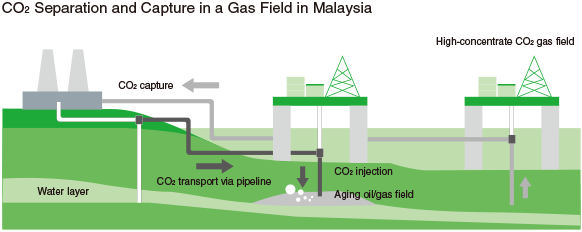
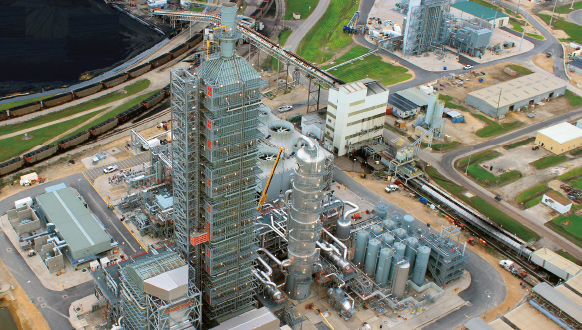
Forest Absorption (Increase of Natural Absorption of CO2)
The Group utilizes natural absorption from forests and other sources as an important means of removing CO2. In order to achieve carbon neutrality in our emissions by fiscal 2040, we are implementing initiatives to create and utilize forest-derived carbon credits in Japan and overseas.
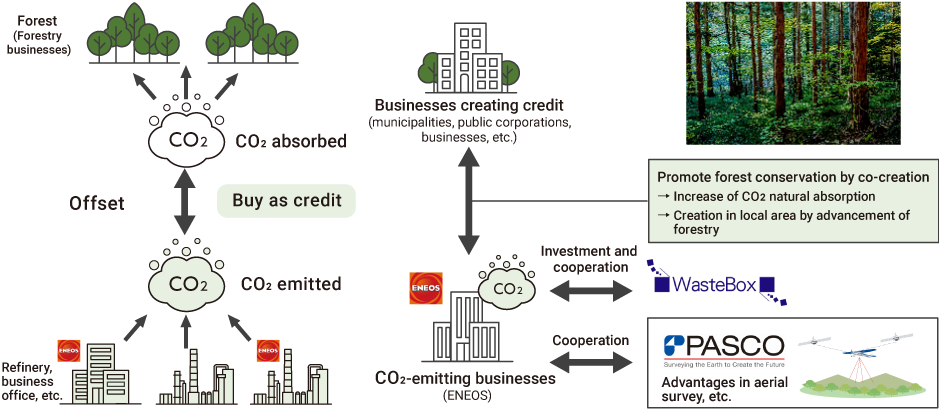
Forest Absorption Projects
| Region | Start | Details |
|---|---|---|
| Japan | January 2022 | Signed a partnership agreement with Kumakogen Town, Ehime Prefecture for the creation of J-Credits* |
| November 2022 | Signed a partnership agreement with Niigata Public Corporation of Agriculture and Forestry for the creation of J-Credits | |
| November 2023 | Signed a partnership agreement with Mori Town, Hokkaido, in collaboration with Nippon Life Insurance Company for the creation of J-Credits | |
| June 2024 | Signed a partnership agreement with Wakayama Public Corporation for Forests and Greenery for the creation of J-Credits | |
| Overseas | July 2023 | Invested in Eastwood Climate Smart Forestry Fund I, a US forestry fund formed by the Sumitomo Forestry Group |
- *A system in which the Japanese government certifies the amount of CO2 and other greenhouse gas emissions reduced through the introduction of energy-saving equipment and the use of renewable energy, as well as the amount of CO2 and other greenhouse gases absorbed through appropriate forest management, as “credits”